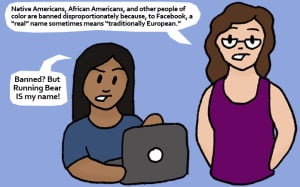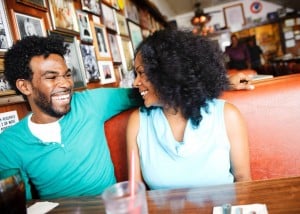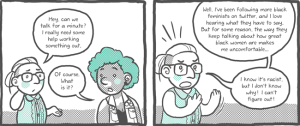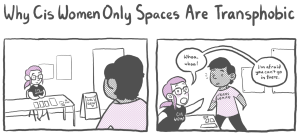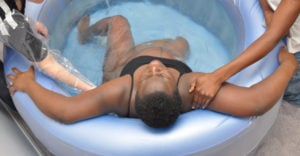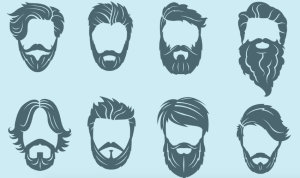
Source: Getty Images
My small and pointy breasts never worried me – until I grew up and they stayed in a premature-looking state.
My breasts have a deformity that prevented them from developing typically and left me with a hardly pubescent chest in my mid-twenties. Literally. Due to arrested development caused by a lack of progesterone, my breasts never flourished far beyond the “bud” stage.
My congenital condition is called Tuberous Breast Deformity (TBD) because of their somewhat elongated and tubular shape. Plastic surgeons acknowledge TBD by the term “Snoopy breasts” because the tubular form reminds them of Snoopy’s nose. Sexy, right? And totally not demeaning at all.
Like any other physical condition, there are different degrees of so-called “severity.” Tuberous breasts aren’t your typical small-breasted beast. Some aren’t even small at all. Structural differences are what make tuberous breasts look different from other breasts.
Women diagnosed with TBD tend to have breasts with “enlarged, puffy areola; unusually wide spacing between the breasts; minimal breast tissue; sagging; higher than normal breast fold; and narrow base at the chest wall.”
Any breast tissue that does grow herniates into the nipple, transforming the boobs into fleshy tubes with bulbous areola. This same nipple herniation is also responsible for creating puffy areola – or “puffies,” as they’re affectionately called by the porn industry.
Before I knew all of this, though, I thought I just had small, awkwardly shaped boobs. I never changed my shirt in the locker room because I didn’t want to attract more negative attention to my body. My small breasts have always factored into my love life due to the fact that I worry about them ever becoming an issue.
Over the years, I’ve found ways to mimic the cleavage effect, but I know the act is up the minute my bra comes off, leaving my bare breasts to stare another person in the face. These intimate moments of “truth” brought a unique kind of anxiety that racked my nerves long after they occurred.
After learning about hypoplastic tuberous breasts, a lifetime of confusion disappeared and revealed a reality I considered ugly: My breasts weren’t just small, but deformed.
Later on, I learned that because TBD is considered a deformity, insurance policies might cover the corrective surgery. That’s right: My breasts had a deformity that insurance companies consider bad enough to intervene on my behalf.
Initially, I was relieved by the idea of getting insurance-covered TBD corrective surgery. I found comfort in the prospect of surgery as I tearfully confessed my discovery to my loved ones.
Most women with my build have voluptuous chests. I loved the idea of topping off my curvy figure with big breasts.
But in the end, I didn’t pursue surgery. Something didn’t feel right about it.
To be clear, I totally respect those with my condition who do decide to get surgery. For
many, undergoing surgery is much more bearable than living the rest of their lives with TBD.
Here are three reasons why I, personally, decided against it.
1. Getting the Surgery Would Perpetuate Sexist Beauty Standards
My breasts never harmed anyone. And the more I thought about it, the more I felt like they don’t deserve to be chopped up to conform to someone else’s vision of beauty.
Sexist beauty ideals coerce us femme folk into valuing our looks more than our hearts. Sexism converts a woman’s beauty into social capital. Without it, we can find ourselves impoverished of friends, dates, jobs, help from strangers when we’re in need, self-esteem, and more. For us, beauty is power.
Meanwhile, if men don’t conform to conventional standards of attractiveness, their accomplishments and personalities are more than enough to compensate for their lack of good looks.
Patriarchy places men’s opinions and experiences as more “default” than those of women. It’s not some magical coincidence that mainstream beauty standards match men’s preferences. The adult industry wouldn’t fixate on big breasts if they weren’t so popular with their heterosexual male audience.
It’s as though a woman’s humanity begins alongside her beauty and ends somewhere along the outskirts of her inner-world. There are entire industries profiting off of our insecurities and a toxic culture that insists upon equating “the halo effect” with actual halos, no matter how angelic we actually are.
The lens through which society perceives feminine beauty is so limited and superficial, there’s not enough room to include our personal details.
Women’s personalities become frames and embellishments when people treat our appearances like the real masterpieces of our lives. And that’s part of the reason why women like me feel so empowered by taking control over our bodies – but there’s more to it than that.
Undergoing surgery of this nature can have very positive results that transcend the value of money. A good bra can work wonders on my confidence; getting TBD corrective surgery would be nothing short of heavenly.
But I shouldn’t have to pay the price for not conforming to beauty standards. By going under the knife, I’d be punishing my breasts for being themselves.
Sure, I wanted to experience every benefit of the buxom glory I’ve been missing out on for my whole life. But in my mind, all of the privileges that increased social capital could’ve afforded me were just perks. A surgery would transform me into the complete plus-size package I’ve always wanted to be.
But now, I see my body as redefining beauty standards rather than failing to live up to them. I am the complete plus-size package without getting corrective surgery.
2. Breast Augmentation Surgery Can Be Dangerous and Expensive
As of now, my boobs are innocent victims of sexist beauty standards. But if I were to get TBD corrective surgery, they would also become casualties of capitalism. It would mean that years of being bombarded with advertisements and cherry-picked models amounted to something: my livelihood.
TBD corrective surgery is risky business. Choosing the wrong surgeon could transform tuberous breasts into double silicone bubbles of oozing trouble. And seeing, thanks to Google, TBD corrective surgeries with poor breast implants gone wrong made me fear for my breasts’ well-being.
Tuberous breasts can’t be fix with just any ol’ breast implants. An anonymous Cosmopolitan contributor wrote about how she credits getting her corrective surgery for saving her life. She said finding a qualified surgeon was difficult because so few doctors know what TBD is.
She wrote that in order “to truly correct [TBD], a surgeon needs to first score the constricted tissue, rounding out the lower part of the breast. And since there are different degrees of severity of this deformity, sometimes elements of a breast lift or reduction are involved” and “sometimes it takes two surgeries, not one.”
She understood that surgery would cost her an excess of $20,000, but the price was worth never having to call in sick due to her depression. She worked in the fashion industry, so her body image issues were encroaching upon her personal health and her professional life.
I decided against surgery. But many women with TBD choose to get surgery to feel better about themselves – and I think that’s a fair choice, too. For many, the danger of living with the mental health effects caused by TBD’s stigma far outweighs the dangers of surgery. I completely understand this choice and admire the strength of anyone who opts for corrective surgery.
For me, I realized that, corrective breast surgery requires a lot of energy, effort, and wherewithal. And I decided that I’d rather reserve that strength for self-healing and combatting the body-negative culture that made me feel so inferior in the first place.
I don’t want to fall prey to the oppressive, yet profitable catch-22 known as “the medical-industrial complex.” This complex keeps the cash coming in sickness and in health.
Patriarchy terrorizes us with the threat of being considered unattractive and therefore, unimportant. Expensive plastic surgeries help women fulfill sexist beauty standards. That’s why American insurance companies only care about your TBD if you have a premium insurance plan.
If I hadn’t been enrolled in the second highest-quality (read: most expensive) plan the insurance company had, they wouldn’t have helped me out with anything other than therapy. I already surrender the bulk of my income to student loans, so dealing with predatory insurance companies weaseling their way out of coverage is out of the question.
At the end of the day, what I asked myself is: Why should I get corrective surgery when I know I’m not the one who needs correcting?
Yes, I would be doing it for myself, but my only problems with my breasts are other people’s opinions. And so, risking my health for the sake of looking good doesn’t seem worth it.
I’ve already spent a lot of time, tears, effort, and not to mention money working through my body image issues in therapy. I spent my youth slashing up my fat, small-chested body with boxcutters because I felt ugly. The last thing I need is more bloodshed.
Mangling my body to fit a patriarchal vision of beauty doesn’t feel right to me. It feels violent.
Sure, many doctors genuinely care about making a positive difference in the lives of their patients. But to me, it feels like paying a professional to mutilate my body.
With that said, I’ve also met plenty of women who got breast implants because they themselves adore big boobs on other women. They seemed to be very happy with their decisions. And that’s awesome. But with my TBD, the insecurity caused by other people’s lack of acceptance and close-mindedness would’ve driven my decision. And that didn’t feel worthwhile to me.
3. I Don’t Have to Apologize for My Breasts
Getting corrective surgery for my tuberous breasts would feel like forfeiting when I still have a great fight to put up against body negativity. Whenever I don’t let other people define my beauty and empower others to do the same, I’m winning.
For most women with tuberous breasts, our chests aren’t what’s actually broken; it’s our hearts.
For years, I was sorry about my TBD – and sometimes, I still am.
The fear of disappointing my intimate partners with my body still rears its ugly head into my thoughts when new love/lust interests enter my life. Self-consciousness still pangs in the pit of my stomach when my crushes express a preference for big breasts. I still worry about my lovers will negatively judging my topless self when I’m naked and vulnerable.
I continue to devote years of conscientious confidence-building and feminism in order to truly embrace my braless body as it is.
I shouldn’t have to go through so much money and suffering to fix something that isn’t broken. I felt like if I got corrective surgery for TBD, it would mean seeking validation from the oppressive systems that kept me down for all those years.
And feeding money into the medical–industrial complex’s anti-tube boob fixation would’ve made me feel like I was perpetuating the problem, rather than actively solving it. Instead, I’ve decided to be part of the solution by staying the way I am.
It’s not easy living with a harmless deformity underneath my chest. And if I had chosen to get plastic surgery, I would’ve done it for the same reason that most other women do: for myself. But once I realized my desire was the product of coercion, I also realized that surgery wasn’t the right choice for me.
I decided that the Itty Bitty Titty Committee needs more tuberous representatives – and it’s my turn to step up to the plate.
[do_widget id=’text-101′]
Ghia Vitale is the Assistant Editor at Quail Bell Magazine. She graduated from Purchase College with a degree in Literature along with minors in Psychology and Sociology. Her work has been featured in Ravishly, Luna Luna, The Horror Zine, Scandalous Women, and more.
Search our 3000+ articles!
Read our articles about:
Our online racial justice training
Used by hundreds of universities, non-profits, and businesses.
Click to learn more





